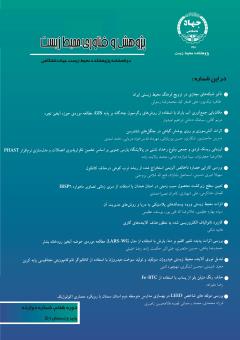ارزیابی ریسک فردی و جمعی وقوع رخداد نشتی در پالایشگاه پارس جنوبی بر اساس تخمین تکرارپذیری اتصالات و مدل سازی نرم افزار PHAST
محورهای موضوعی : ایمنی بهداشت و محیط زیست(HSE)
غلامرضا جعفرنژاد
1
,
سینا دوازده امامی
2
![]() ,
محمد ولایت زاده
3
,
محمد ولایت زاده
3
![]()
1 - گروه ایمنی صنعتی، موسسه آموزش عالی تابناک، لامرد، فارس، ایران.
2 - گروه ایمنی صنعتی، موسسه آموزش عالی تابناک، لامرد، فارس، ایران.
3 - گروه ایمنی صنعتی، موسسه آموزش عالی کاسپین، قزوین، ایران.
کلید واژه: نشت گاز, ارزیابی ریسک فردی, تکرارپذیری اتصالات, مدل سازی PHAST, پالایشگاه پارس جنوبی,
چکیده مقاله :
در این تحقیق، بهمنظور بررسی محدوده اثر دو نوع آتش Flash Fire و Jet Fire و تعیین ریسک فردی و جمعی مربوط به مخازن گاز پالایشگاههای پارس جنوبی، از روش ارزیابی کمی ریسک با استفاده از نرمافزار PHAST استفاده شد. برای به دست آوردن تکرارپذیری برای سناریوی نشتی فلنج شیر ورودی و خروجی، تمام اتصالات موجود در مسیر برای هر سناریو بهطور جداگانه مورد بررسی قرار گرفته و تکرارپذیری آن ها محاسبه شدند. نتایج نشان داد که از میان نشتیها، نشتی مربوط به فلنج شیر ورودی و فلنج شیر خروجی، با توجه به موقعیت مکانی آنها از اهمیت بیشتری برخوردار است. نمودار کانتور ریسک فردی حاصل از ترکیب دو سناریو شیر ورودی و شیر خروجی است که نشاندهنده میزان مرگومیر در سال در محدودههای مشخصشده می باشد نمودار ریسک جمعی از ترکیب تکرارپذیری و تعداد تلفات در سال تشکیلشده است که در محدوده حد بالا و حد متوسط قرار دارد و این بدین معناست که ریسک جمعی منطقه تحت بررسی بالا می باشد. با توجه به شرایط در پالایشگاه پارس جنوبی ازنظر شرایط آب و هوایی منطقه، سرعت و جهت وزش باد، جهت وزش باد غالب، جانمایی ساختمانهای موجود در ایستگاه و توزیع جمعیتی آن به این نتیجه میرسیم که در صورت وقوع رخداد نشتی، پیامد آنکه بهصورت انتشار گاز قابل اشتعال و دو نوع آتش محتمل Jet Fire و Flash Fire می باشد، از محدوده معین موردنظر خارج بوده و این امر میتواند تبعات جبرانناپذیری جانی و مالی به همراه داشته باشد.
In this research, in order to investigate the scope of the effect of two types of fire, Flash Fire and Jet Fire, and to determine the individual and collective risk related to the gas tanks of South Pars refineries, the quantitative risk assessment method was used using PHAST software. To obtain reproducibility for the inlet and outlet valve flange leakage scenario, all connections in the path were examined separately for each scenario and their reproducibility was calculated. The results related to the gas tanks of South Pars refineries showed that among the leaks, the leakage related to the inlet valve flange and the outlet valve flange, according to their location (close to the car parking lot and vehicle traffic road as well as the traffic route) people and buildings around it) is more important. The individual risk contour diagram is the result of the combination of two scenarios, inlet valve and outlet valve, which shows the amount of deaths per year within the specified limits. This means that the collective risk of the area under investigation is high. Considering the conditions in the South Pars Refinery in terms of regional weather conditions, wind speed and direction, prevailing wind direction, the location of the buildings in the station and its population distribution, we come to the conclusion that in the event of a leakage incident, the consequences It is in the form of release of flammable gas and two possible types of fire, Jet Fire and Flash Fire.
1. Jafari M, Davazdah Emami S, Velayatzadeh M. Consequences of Fire and Explosion in Distillation Unit of Persian Gulf Star Gas Condensate Refinery Using PHAST Software. ohhp. 2022; 6 (1): 13-28. (In Persian).
2. Kashi, Islam, Bahmanpour, Homan and Habibpour, Sultanali, 2013, risk assessment of process accidents in Gachsaran 1200 LGN Gas Refinery, 14th National Congress of Chemical Engineering of Iran, Tehran, 5 p. (In Persian).
3. Bucelli, M., Landucci, G., Haugen, S., Paltrinieri, N., & Cozzani, V. (2018). Assessment of safety barriers for the prevention of cascading events in oil and gas offshore installations operating in harsh environment. Ocean Engineering, 158, 171-185.
4. Jo, Y. D., Park, K. S., Kim, H. S., Kim, J. J., Kim, J. Y., & Ko, J. W. (2010). A quantitative risk analysis method for the natural gas pipeline network. WIT Transactions on Information and Communication Technologies, 43, 195-203.
5. Ma, L., Cheng, L., & Li, M. (2013). Quantitative risk analysis of urban natural gas pipeline networks using geographical information systems. Journal of Loss Prevention in the Process Industries, 26(6), 1183-1192.
6. Sugawa, O., & Sakai, K. (1995). Flame length and width produced by ejected propane gas fuel from a pipe. Fire Safety Science, 2, 411-421.
7. Zhang, L., Wu, S., Zheng, W., & Fan, J. (2018). A dynamic and quantitative risk assessment method with uncertainties for offshore managed pressure drilling phases. Safety science, 104, 39-54.
8. Freeman, R. A. (1990). CCPS guidelines for chemical process quantitative risk analysis. Plant/Operations Progress, 9(4), 231-235.
9. Ronza, A., Muñoz, M., Carol, S., & Casal, J. (2006). Consequences of major accidents: Assessing the number of injured people. Journal of hazardous materials, 133(1-3), 46-52.
10. Online available in http://www.meadowbrooktoday.com/id141.html.
11. Bagheri Mojtabi, Badri Nasser, Rashtchian Davoud, Iqbalian Hoshang 2013. Determining the safe space of sour gas transmission pipelines by the method of quantitative risk assessment. Iranian Journal of Chemistry and Chemical Engineering 32 (2): 57-71. (In Persian).
12. Bowen, J., & Stavridou, V. (1993). Safety-critical systems, formal methods and standards. Software Engineering Journal, 8(4), 189-209.
13. Khan, F. I., & Abbasi, S. A. (2001). Risk analysis of a typical chemical industry using ORA procedure. Journal of Loss Prevention in the Process Industries, 14(1), 43-59.


